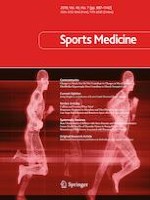Published in:

01-07-2019 | Systematic Review
Geometric and “True” Densitometric Characteristics of Bones in Athletes with Stress Fracture and Menstrual Disturbances: A Systematic Review
Authors:
Rebecca J. Mallinson, Emily A. Southmayd, Mary Jane De Souza
Published in:
Sports Medicine
|
Issue 7/2019
Login to get access
Abstract
Background
Stress fractures can lead to short- and long-term consequences, impacting participation in sport and general health. Recognizing which skeletal characteristics render bones susceptible to stress fracture may aid stress-fracture prevention. Menstrual disturbances among exercising women are a known risk factor for stress fracture; therefore, assessing skeletal commonalities between women with stress fractures and women with menstrual disturbances may increase our understanding of why menstrual disturbances put athletes at greater risk for stress fracture. Three-dimensional (3D) bone imaging tools provide detailed information about volumetric bone mineral density (vBMD) and bone structure that cannot be obtained using traditional two-dimensional (2D) techniques.
Objectives
This systematic review serves to: (1) evaluate the current literature available on vBMD, bone geometry, and bone structure in exercising women with menstrual disturbances and exercising women with stress fractures, and (2) assess the common skeletal characteristics between both conditions. Our aim is to reveal bone properties beyond 2D areal BMD that may indicate increased susceptibility to stress fracture among exercising women with menstrual disturbances.
Search Methods
A search of the PubMed/Medline database was completed in May 2018.
Eligibility Criteria
Eligible articles included those that reported vBMD, bone geometry, or bone structure obtained from 3D imaging techniques or estimated from 2D imaging techniques. Only studies conducted in premenopausal exercising women and girls who had a stress fracture, a menstrual disturbance, or both were included.
Results
Twenty-four articles met the inclusion criteria. Bone area and cortical thickness at the tibia were identified as altered both in women with menstrual disturbances and in women with stress fractures; however, there was inconsistency in the results observed for all bone parameters. The majority of skeletal parameters of the lower extremities were not significantly different between exercising women with and without stress fractures and between those with and without menstrual disturbances.
Discussion
Most studies were moderate or low quality based on study design, and only one article combined both conditions to explore vBMD and bone geometry in athletes with menstrual disturbances and a history of stress fracture. These findings highlight the need for more skeletal research on the intersection of these health conditions in exercising women. The lack of observed differences in skeletal parameters suggests that risk factors other than bone geometry and structure may be the primary causes of stress fracture in these women.
